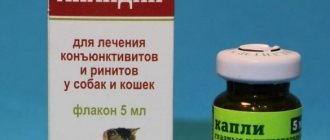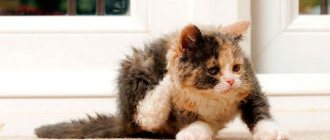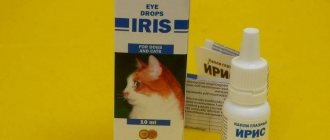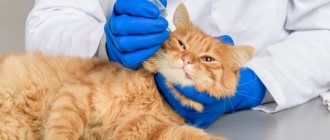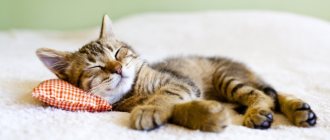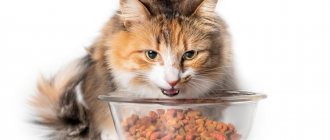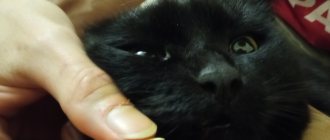In the treatment of all eye diseases in cats, drops are required. However, in veterinary pharmacies and pet stores their range is very wide, and sellers often recommend expensive and not the most effective products.
This article will help the owner understand the beneficial properties of popular eye drops and choose an inexpensive and effective drug for the cat.
Types of eye drops
Eye drops that are used to treat the eyes of cats are divided according to the type of action:
- Antibacterial. These drugs contain antibiotics. They are used in the treatment of infections caused by bacteria (keratitis, conjunctivitis, blepharitis, etc.).
- Antihistamines. These remedies are used to eliminate allergic reactions accompanied by redness of the mucous membrane of the eyes, copious clear discharge, and swelling of the eyelids.
- Antiseptic. These medications are effective for eye diseases complicated by fungus. They cleanse the mucous membrane of pus and other secretions and disinfect affected tissues.
- Antiviral. They are used for viral infections that affect the pet’s eyes (rinotracheitis, etc.). The main component of such drugs is interferon. Drops stimulate local immunity and speed up the healing process. Often such drugs are prescribed in conjunction with antibiotics.
- Anti-inflammatory. These drugs contain components that quickly relieve the inflammatory process. They are used to treat injuries, inflammation caused by mechanical damage, conjunctivitis and other ailments.
- Moisturizing. Such drops are not used for treatment, but they are effective for increased dryness of the cornea. Some drugs contain components that can prevent the development of keratitis and other diseases.
You should not prescribe the drug yourself. If your cat has problems with its eyes, you should show it to an ophthalmologist, who will prescribe a competent treatment regimen.
IMPORTANT! Incorrectly selected medications can only aggravate the course of the disease, which will lead to complications and even blindness of the pet.
Eye diseases in cats
The range of ophthalmological problems in cats is quite wide:
— conjunctivitis is an inflammation of the mucous membrane of the eye, which may be caused by an infection or an allergic reaction. Symptoms of the disease are as follows: lacrimation and mucus secretion, swelling of the mucous membrane, swelling of the eyelids;
- blepharitis - inflammation of the eyelids. Symptoms of the disease are thickening of the edges of the eyelids, rejection of skin cells, suppuration;
- keratitis - inflammation of the cornea caused by inflammation, mechanical, chemical or thermal damage. With this disease, the eye becomes less shiny and cloudy;
- iritis (and iridocyclitis/uveitis) - inflammation of the iris (and ciliary body). Its causes can be infections of various natures, fungal diseases, ascariasis, and intoxication of the body. The disease can be identified by the following signs: painful reaction to light, yellowness of the iris, constriction of the pupil, secretion of mucus and pus;
- glaucoma - enlargement of the eye due to increased pressure in the eyeball. With this disease, the retina and optic nerve nipple may atrophy;
- cataract - clouding of the lens. This is a disease of older or diabetic cats.
In addition to these diseases, cats often suffer from injuries, erosion, and ulcers of the eye tissue.
Popular eye drops for cats
Among the many eye drops, there are those that are used most often to treat cats:
- AVZ Diamond eyes. The active ingredients are chlorhexidine, succinic acid and taurine. The drug perfectly relieves inflammation, destroys bacteria and viruses. The drug is prescribed for mild conjunctivitis and lacrimation. From 1 to 3 treatments are done per day, one drop is instilled into each eye. The duration of treatment is from 14 to 45 days, depending on the number of daily treatments.
- Tsiprovet. The main component is ciprofloxacin. Drops relieve inflammation, destroy various pathogenic microorganisms (chlamydia, staphylococci, mycoplasma, etc.). Prescribed for eye infections: blepharitis, conjunctivitis, keratoconjunctivitis, keratitis, corneal ulcer. The medicine is used in eye surgery to prepare a pet for surgery and recovery after it. Treatment regimen: 4 times a day, one drop in each eye for 1-2 weeks.
- Iris. Includes gentamicin sulfate and additional components. The medicine relieves inflammation, has a detrimental effect on many bacteria, except anaerobic ones, but is not effective against viruses, fungi and protozoa. It is used for keratitis, conjunctivitis, blepharitis, uveitis. Dosage for cats: 1 drop in each eye for a week.
- Leopard. The composition includes furatsilin and chloramphenicol. The drug is effective in the treatment of diseases caused by bacteria (Gram-positive or gram-negative) and some viruses. It is prescribed for conjunctivitis, keratitis and blepharitis, as well as for mechanical eye injuries.
- Anandin. The main component is glucoaminopropylacridone. This remedy is used to treat infectious rhinitis and conjunctivitis. 2 drops are instilled into each eye, the duration of therapy is 5-7 days.
- Beafar Oftal. This product is intended to cleanse your pet's eyes only. Apply 2-3 drops to each eye, and then carefully clean the eye with a cotton pad towards the nose. This treatment can be done up to 2 times a week.
There are other eye drops, many of which have similar effects. When choosing, you should rely on the veterinarian’s recommendations, the cost of the drug and its availability.
Review of the most effective eye drops for cats
In pharmacology, eye drops for cats and cats are divided into several groups according to their purpose:
- Caring drops and lotions with an antiseptic composition (with herbal extracts, silver ions, succinic acid, chlorhexidine and other antiseptics). They are intended for the prevention of eye diseases and rinsing of the eyelids. These include Diamond Eyes, Lakrikan, Ophthalmosan.
- Antiallergic eye drops – relieve itching, redness and swelling in case of hypersensitivity in the animal. For example, Ophthalmostop, Dekta-2.
- Antibacterial eye drops with broad-spectrum antibiotics (Iris, Bars, Tsiprovet).
- Antiviral drops that accelerate recovery from infectious diseases of cats. These include Maxidin and Anandin (eye and intranasal drops).
Human eye drops are sometimes used from a first aid kit for cats. Most often, veterinarians prescribe the drugs Tobrex and Levomycetin.
Important! Medications and dosage for kittens should be determined by a veterinary ophthalmologist, due to the presence of contraindications and age restrictions.
Tsiprovet
Among antibacterial eye drops for cats, Ciprovet is the most effective, since it contains potent ciprofloxacin in a 0.45% concentration.
The drug is prescribed for various cat inflammatory processes in the eyes, which are accompanied by purulent discharge, regardless of etiology. Often Tsiprovet is prescribed after drops of Iris or Bars, if the desired therapeutic effect was not obtained from the previous treatment.
The advantages of the drug are explained by the action of the active component: destruction of the genome and protective shell of the bacterium, as well as prevention of the development of resistance of microorganisms. All this makes it possible to achieve a long-term positive effect in the local treatment of eye diseases in cats.
Veterinary surgeons also use Tsiprovet before and after ophthalmological operations on the eyes of cats as a prevention of infectious complications.
Important! Ciprovet drops should not be administered to kittens less than 1 week old. When instilling the product into adult cats, a short-term burning sensation in the eye may occur, which will be noticeable by the animal’s behavior (attempting to scratch the eye, shaking the head, lacrimation).
Iris
These are the second most popular antibiotic eye drops that are prescribed to cats for various inflammations.
The active component of the drug is gentamicin in a 0.4% concentration.
The action of the drug is aimed at many bacteria, including Pseudomonas aeruginosa. There is no effect when the eyes are damaged by fungi, viruses and protozoa, as well as bacteria resistant to gentamicin.
How Iris works: after instillation into the conjunctival cavity, the product penetrates deep into the diseased eye and disrupts the process of division of pathological bacterial cells, which prevents the spread of infection.
Drops are used as a treatment for ulcers and erosions of the cornea, keratitis, blepharitis, injuries, in order to prevent the aggravation of the process and the development of secondary microflora.
Leopard
These are anti-inflammatory drops for cats, dogs and rabbits. The active ingredients are 0.25% chloramphenicol (also known as chloramphenicol) and 0.02% furatsilin.
The combination of two strong substances in the drug causes success in the treatment of primary conjunctivitis of bacterial origin and even some viruses in cats.
Bars - indications for use and prevention of eye diseases:
- washing the eyes in case of injuries, penetration of a foreign body;
- uncomplicated conjunctivitis, when there is no discharge of pus and formation of crusts of dried exudate;
- with a diagnosis of “keratitis”, “blepharitis”;
- cats with a tendency to frequent conjunctivitis to prevent the development of another inflammation.
Bars eye drops are considered low-risk and are well tolerated by kittens.
Important! Bars is one of the few drugs approved for use in rabbits. This once again proves its safety for particularly sensitive pets.
Anandin
Based on the name of the drug (eye and intranasal drops), the medicine can be used in two ways: to treat the eyes and nose.
The composition of Anandin for the eyes is represented by one active ingredient - 2% glucoaminopropylacridone, which has an anti-inflammatory, antimicrobial and wound-healing effect.
The complex mechanism of action of the drops is aimed at producing its own interferon, increasing the activity of protective cells (T-lymphocytes and macrophages), and enhancing the production of anti-inflammatory agents of the body.
The main purpose of Anandin is to treat watery cat eyes and rhinitis (runny nose).
The drug does not cause burning or other uncomfortable sensations in animals during treatment, therefore it is successfully used for kittens.
Dekta-2
Decta-2 cat eye drops are a combination medicine that consists of the antibiotic gentamicin and the hormonal dexamethasone.
As a rule, the main purposes for using the product are:
- allergies with tearing and bacterial microflora;
- blepharitis;
- keratitis;
- iritis and cyclitis (iridocyclitis);
- during ophthalmological operations.
When treated with Decta-2 drops, the active components of the drug relieve swelling, reduce capillary pores and destroy pathological microflora, which ensures a lasting therapeutic effect.
Important! Decta-2 is combined with other drugs for local eye treatment, which allows it to be used as a second medication in the treatment of complex conjunctivitis.
Levomycetin
This is a human medicine - eye drops with the active ingredient of the same name.
Due to the complete similarity with the veterinary drug Bars in terms of concentration of chloramphenicol (active component), the prescription and dosage will be similar. Accordingly, the drug can be used by adult cats and female cats, as well as young animals, without fear.
Diamond eyes
Preventative drops Diamond eyes are very popular among veterinarians and pet owners.
They are prescribed for treating eyes with severe lacrimation with characteristic wet tracks on the face and for daily care of the eyes of healthy cats. Just one drop of a hygienic solution can stop the onset of catarrhal conjunctivitis in a cat.
Ingredients: chlorhexidine, taurine (an amino acid that supports acute vision in cats) and succinic acid (provides resistance to infections).
Highly recommended for red eye syndrome and cat injuries. Regular use in older pets helps prevent cataracts and destructive processes in the retina and cornea of cats' eyes.
Tobrex
This is a human drug that is used in veterinary medicine as an effective remedy for ophthalmic problems in cats.
Tobrex consists of tobramycin (a broad-spectrum antibiotic) and excipients. It makes sense to use these drops if the cat’s eye is very inflamed, and treatment with veterinary drugs does not give a pronounced effect.
Maxidin
Maxidin is a veterinary drug with a complex composition that has immunomodulatory properties. According to the method of application, it refers to ophthalmic and intranasal agents.
It is used primarily for viral conjunctivitis, keratitis and runny nose in cats. Prescription is allowed if other eye drops are intolerant.
How to put drops in a cat's eyes
Dropping medicine into your cat's eyes is quite simple. The pet is picked up and soothed by stroking. Then the cat is placed on its knees with its back down, the paws are fixed by an assistant, but you can carefully wrap it in thick fabric, leaving only the head outside.
The eyes are cleansed of pus and other secretions using cleansing lotions and drops (Cliny, YUGI, EYE Cleaner, etc.). To do this, they are dropped into the eyes and then removed with a cotton swab or gauze.
The lower eyelid is carefully pulled down, and with the other hand the required number of drops is applied to the mucous membrane. After treatment, the pet must be held in your arms to prevent it from scratching its eyes.
IMPORTANT! Any eye treatment is carried out in the direction from the outer corner to the nose. Thanks to this, the discharge will not remain on the mucous membrane.
Rules of application
Rules of use and recommended dosages are contained in the instructions for each drug for the treatment of eye diseases in cats. There are also general recommendations that must be followed when trying to help your pet on your own:
- before using the drug, you need to make sure that it is intended for animals and has antibacterial properties, and its shelf life has not yet expired;
- Before putting drops into the cat’s eyes, you need to use a swab moistened with warm water to remove crusts and accumulations of mucus on the eyelids and around;
- make sure that the animal is securely restrained and does not jerk its head, causing injury to itself on the dropper spout.
Precautionary measures
When treating cat eyes, precautions must be taken. Hands are washed with soap and water before and after the procedure. Do not eat or drink while working with medications.
If drops get on your skin, it is recommended to wash them off with running water as soon as possible. The cat is carefully restrained throughout the procedure, as it can escape and seriously injure the person holding it.
Eye drops are popular medications among cat owners. They are used both for treatment and for regular cleansing of the cat's eyes. Some medications can help cope with corneal dryness, which often affects flat-faced pets (Persians, exotics, etc.).
